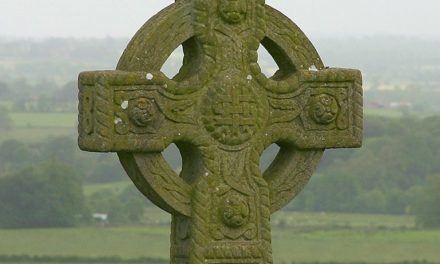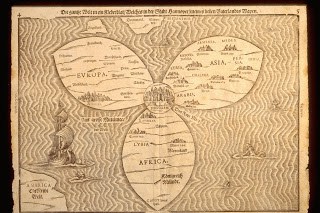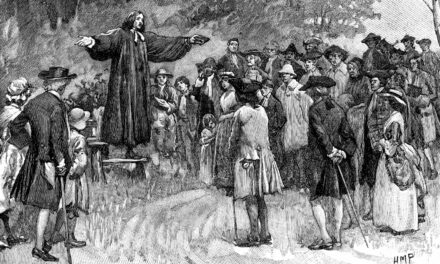This week’s episode is titled “Buy One, Get One Free.”
In the last episode we touched briefly at a heretic named Marcion. He was one of the first to introduce a false teaching that would evolve into a major challenge to the emerging Christian Faith; that errant movement was known as Gnosticism.
Marcion was the son of the pastor of the church in Pontus, on the Southern coast of the Black Sea. He was a ship-owner sailing passengers & shipping cargo throughout the Empire. Around AD 140, Marcion’s father disfellowshipped him from the congregation. This was the result either of Marcion’s seduction of a young woman, his increasingly heretical ideas, or both. Whatever the reason, he relocated to Rome where he was unknown & his reputation was untarnished. When he made a large contribution to the church at Rome, it greased the wheels of his acceptance as a member in good standing.
But Marcion soon began espousing ideas that diverged from what the elders taught. In his previous travels, Marcion had been influenced by a teacher named Cerdo, an early advocate of what today is known as Gnosticism.
Now, let me be clear, Gnosticism was more a religious trend than a united movement with a settled set of doctrines. While Gnostics held a common set of core beliefs, they interpreted them widely. This makes describing Gnosticism difficult. Generally, we can say it was a mash-up of à
- Greek philosophy,
- Eastern mystery cults, and
- Christian terminology.
From Greek philosophy, Gnostics borrowed the idea that all physical matter was inherently an unalterably evil, while the spiritual realm was equally, inherently & unalterably good. From esoteric & occult Eastern mystery sects they took the idea there was a secret body of knowledge that when understood granted enlightenment. This enlightenment was the Gnostic equivalent of salvation because it liberated one’s consciousness from mere physical existence into a kind of permanent spirituality.
Gnosticism took its name from this idea of “salvation thru enlightenment.” The Greek word ‘gnosis’ means ‘knowledge.’
Because the Christian movement was growing rapidly, Gnostics adopted Christian forms & terms as a sneaky marketing ploy, hoping to pawn off their ideas as an elite form of Christianity. The ploy worked & Gnosticism took root in several congregations just as winds of false teaching do in every generation.
Marcion was one of the first to introduce Gnostic elements in his highly-edited form of Christianity. Drawing from Cerdo, he proposed 2 different gods; an angry, vengeful OT deity, & a warm, fuzzy father-figure of the NT. Toting the Gnostic line, Marcion said the physical body was evil & promoted a rigorous asceticism that denied all physical pleasure. Marcion’s followers took communion by drinking water because wine was too tasty. They went so far as to say even marital sex was taboo.
Marcion claimed Jesus was not born of Mary. He said Jesus appeared at Capernaum in AD 29 as a grown man. Note that = Jesus only appeared. Marcion said Jesus didn’t have a literal body. He couldn’t since being physical, the body was evil. Jesus only appeared, or seemed to have a body; in truth, he was more phantom than tangible.
This is called Docetism; one of the earliest forms of Gnosticism. Docetism comes from the word meaning to seem. Marcion said the death & resurrection of Christ weren’t literal; they couldn’t be since Jesus wasn’t corporeal. They were just a phantom demonstration of God’s love and sacrifice. Though the church at Rome quickly became hip to Marcion’s theological shenanigans & declared his ideas heretical in 144, they gained some traction and Marcion set up a counterfeit church in both Italy & in Asia Minor where the Eastern mystery cults were popular. Marcionite fellowships reached as far as Arabia & Egypt & were still operating well into the 4th Century.
Marcion’s was only one of several streams of Gnosticism that developed during the 2nd & 3rd Centuries to challenge Christian orthodoxy. The main feature of all the Gnostics was their sharp dualism, splitting up the physical & spiritual into utterly divergent realms. They believed the spiritual realm contained a hierarchy of spiritual beings who were layered upward toward a transcendent & ultimate spirit. This transcendent god had given rise to a lower deity, which had done likewise, & so on over thousands of spiritual emanations until there was a spirit distant enough from the origin to be so low as to be able to create the physical universe. Some Gnostics like Cerdo & Marcion, said this lowly creator spirit was the Jewish God of the OT.
Gnostics believed that sparks of divinity, little portions of pure spirit were locked inside some, but not all, humans. Those who had them, they said, would become Gnostics. Another clever marketing ploy; after all, who doesn’t want to think they have a little spark of something special? So, they were tempted to go Gnostic to prove they did. The next step was to pay one of the Gnostic teachers the requisite fee to learn the Gnosis, that is, the secret knowledge, so they could have their divine spark fanned into full flame.
Voilà = Enlightenment!
It was an ancient version of, “The first lesson is free, but if you want to go deeper, well, that’s going to cost you. Oh, & by the way, if you’re smart, you WILL join us – because that’s what smart holders of the divine spark do. You want to be one of the special one’s don’t you? Well, sign up, pay the fee & you’re in! Oh and BTW – if you sign up today, it’s half off.”
Okay, I obviously made that last part up, but once you realize what the Gnostic teachers were all about, you wouldn’t’ really be surprised if they did have ancient versions of all the modern sales gimmicks. Family & group plans, Buy One; Get One Free, No Shipping.
For the Gnostics, Enlightenment equaled Salvation. It was the realization they weren’t mere humans devoid of the divine spark, so little better than animals. They were earth-bound spirits destined to re-emerge with the divine hierarchy, that series of emanations from the supreme, transcendent God. Gnosticism was a stepped progression of spiritual growth whereby members increased their rank by paying their Gnostic guides more & more to learn increasingly powerful gnosis. If this sounds similar to a modern religious group that calls itself by a similar name = Something like, uhhh à Knowledgeology = Well there really is nothing new under the sun.
Gnosticism presented a challenge to the Church for a couple of reasons.
First = Gnostics used many of the same terms Christians used. This confused novices and those not properly taught. It’s something pseudo-christian cults do to this day. They use orthodox vocabulary but pour different meanings into the words.
Second = It’s human nature to be attracted to that which is secret, hidden & mysterious; and that’s what the Gnostics were all about.
Third = The Gnostics believed they were superior to others. This appealed to ever-present pride. The Bible teaches that humans were created in the image of God & originally destined for glory. There’s a latent sense of a call to glory that lingers in the soul. Greatness beckons us all. Gnostics said this was the divine spark & only they could activate it.
Fourth = Human nature assumes something as important as salvation has to be costly. There’s no such thing as a free-lunch. The Christian Gospel says while salvation is by God’s grace & free to us, it’s supremely costly to God because it cost the Life of Christ. But many miss this & think grace is utterly free. The Gospel’s message of salvation by grace seemed thin & weak to those convinced there had to be work involved, compared to the Gnostic campaign of “Pay to Play.”
What comes as a surprise is to realize the first real doctrinal challenge to Christianity was not over Jesus’ deity. It was over His humanity. Today, most controversy is over Jesus being God. It’s easy to see Him as a man. What’s more difficult is to understand how the human and divine come together in the Incarnation, so this becomes one of the main points of contention with non-Christian and the cults. The Docetism of Marcion and other Gnostics maintained Jesus’s divinity but denied his humanity.
And let me just give a bit of a teaser for some of our later episodes when we get to the 4th & 5th Centuries. Turns out the battles that went on in the church over how to understand the dual nature of Christ became a bloody & contentious period of Church history. One of the Church Councils is nick-named the Gangster Synod because the church leaders who attended it beat each other up over this issue. è Fun times!
Back to Gnosticism . . .
Other branches of the Gnostics taught Jesus & Christ were 2 separate entities. Jesus was just a man with a human mother & father while Christ was a spirit that descended on the man Jesus at his baptism, ministered thru him for 3 yrs, then departed in the Garden of Gethsemane. So the man that died on the cross was just a spent shell; his death accomplished nothing in terms of salvation. These Gnostics claimed that the Christ-spirit or Christ-consciousness continued to inhabit their leaders & could come upon anyone who showed sufficient enlightenment.
Like Marcion with his abbreviated list of approved books we considered in the previous episode, the Gnostics edited portions of the NT that spoke of Christ’s physicality. They couldn’t have Him writing in the dust of the ground or eating after the resurrection because, well, spirits don’t do those kinds of things. They also had to insert episodes into the Jesus-story that gave an opening for their aberrant theology. The recent spate of alternative Gospels that have made the news are for the most part Gnostic Scriptures known to the early church but rejected for their spurious origin and dubious Gnostic purpose. They weren’t included in the NT canon because they didn’t meet the strenuous criteria used to validate accepted writings.
As I mentioned, there were several branches or streams of Gnosticism. They differed in all sorts of ways. One of the major divisions was on how to deal with their core-belief in the inherent evil of all matter. One group believed the proper way to respond was by a strict asceticism that avoided physical pleasure. They ate only the most bland foods , drank tasteless beverages, wore uncomfortable clothes, abstained from sex & avoided any stimulation of the senses deemed pleasurable.
The other tendency was a 180° reversal of asceticism. These Gnostics immersed themselves in physical pleasure. They said asceticism was pointless because whether it was pleasurable or not, contact with the world was unalterably evil – so it didn’t matter! If it was all evil, might was well enjoy it! These Gnostics made it their aim to so immerse themselves in pleasure, and this often meant indulging in the grossest kinds of immorality, that they’d experience enlightenment anyway, and this would prove that their consciousness was divorced from the body. These Gnostics said their divine spark was like a pearl that could not be stained by the muck of the world. Of course, this was quite appealing to people who wanted to continue in sin and believe they were going to heaven when they died.
Spread between these extremes, were other branches of Gnostic thought & teaching.
Until the 19th Century most of what we know about the Gnostics came from Christian leaders like Irenaeus & Origen who refuted their ideas.
Here’s what the Early Church Father, Irenaeus, wrote about the Gnostics in his preface to his work; “Against Heresies.”
These men falsify the oracles of God, and prove themselves evil interpreters of the good word of revelation. They also overthrow the faith of many, by drawing them away, under a pretense of superior knowledge, from Him who rounded and adorned the universe; as if they had something more excellent and sublime to reveal, than God who created the heaven and the earth, and all things therein. By means of specious words, they cunningly allure the simple-minded to inquire into their system; but they nevertheless clumsily destroy them, while they initiate them into their blasphemous and impious opinions . . . and these simple ones are unable, even in such a matter, to distinguish falsehood from truth.
As I said, until recently, pretty much all historians knew of ancient Gnosticism was what it’s opponents said about it. Then, several decades ago, ancient Gnostic manuscripts began to surface. The more notable of these are the Codex Askewianus, the Gospel of Mary Magdalene, the Wisdom of Jesus, & the Acts of Peter. In 1946, a collection of Gnostic manuscripts was discovered near Nag Hammadi in Egypt. They were dated to the late 4th Century.
Simon Magus, mentioned in Acts 8, was labeled by early Christians as the originator of Gnosticism and may indeed have had a hand in blending Greek philosophy, Eastern mysteries, & Christian lingo into a home-spun spiritualism. After Simon, another Gnostic teacher named Menander followed up on & elaborated on Simon’s work. Saturninus brought Gnosticism to Antioch in Syria where a thriving Christian community already existed.
Cerinthus spread Gnosticism in Asia Minor & as we’ve seen Cerdo & Marcion brought Gnostic ideas to Rome.
Where Gnosticism thrived was in the North African city of Alexandria, the Roman Empire’s 2nd largest & a highly-influential city. Alexandria was a center of culture & learning & Gnosticism’s presence there greatly advanced its reach.
The arid conditions of North Africa facilitated the preservation of documents, so some of our most ancient manuscripts of the NT come from that region. Some conservative scholars believe these manuscripts bear evidence of Gnostic tampering in that they tend to exclude portions of the Gospels that reference Jesus’ corporeal existence, as well as those parts of the NT epistles which speak of the life of Faith affecting the physical world.
But the net result of Gnosticism on the Church was the clarification of what Christians believe about the humanity and deity of Christ & the nature of faith. Gnostic challenges moved Church leaders to identify which books were Scripture as well as what makes for essential doctrine. Though the cause of orthodoxy was advanced by confronting Gnosticism, Gnostic ideas became entrenched in some churches and by the early 4th Century, when Christianity was finally removed from under the heel of Imperial persecution, Church leaders were split over some of the ideas Gnosticism had inserted.
But that’s a matter for a latter episode.






“Pay to play – that sounds like the selling of Indulgences that Luther railed against. The “Gangster Synod”!, over the dual nature of Jesus, wow! Reminds me of some of the historic bibles, and the names they are referred to as…
Love the Podcast, but also love to read the transcripts. You don’t happen to have the transcript for this episode available do you?
Kelvin – Look for an invitation to Google Drive